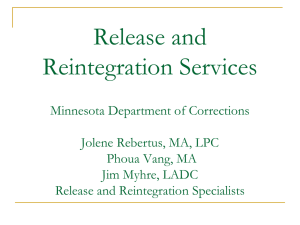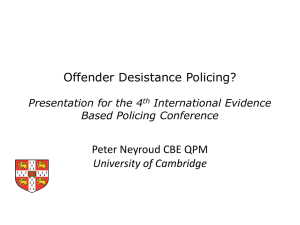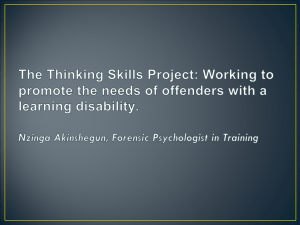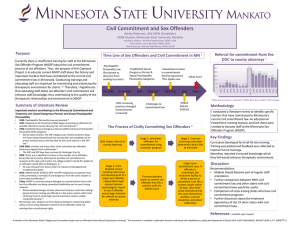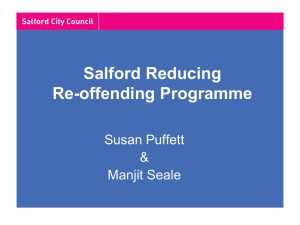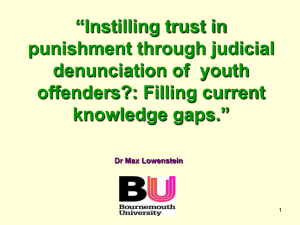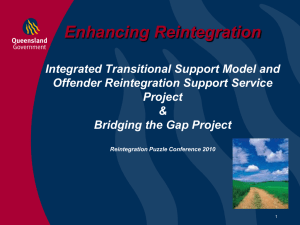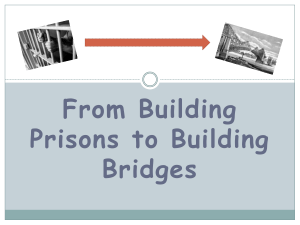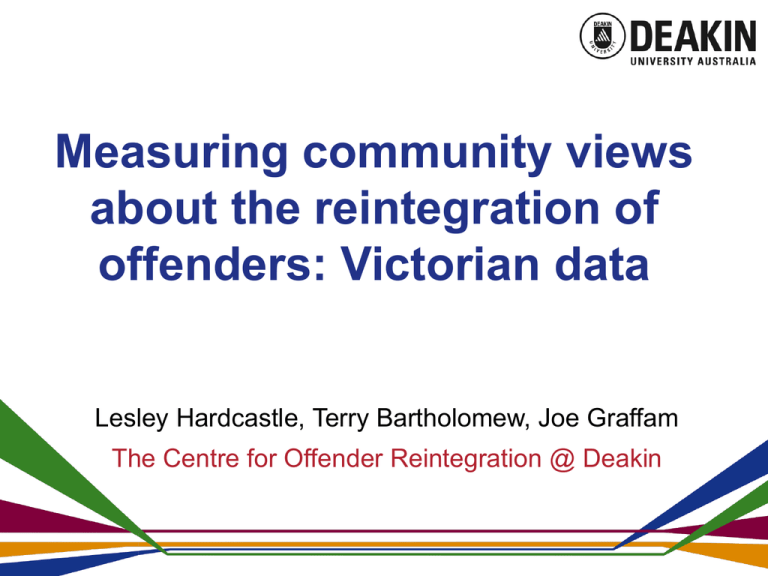
Measuring community views
about the reintegration of
offenders: Victorian data
Lesley Hardcastle, Terry Bartholomew, Joe Graffam
The Centre for Offender Reintegration @ Deakin
Outline
Background
Rehabilitation v reintegration
Our study
Some trends and implications
Background
30 June 2005–30 June 2009: 17.8% increase in
incarceration rates (males 18.4%, females 9.7%)
27.7% of male prisoners have sentences of < 12
months (42.5% of females)
46.6% sentences of 1 yr – <5 yrs (females 40.5%)
50% all prisoners prior adult imprisonment
33.9% released 2006–7 had returned within 2 yrs
(42.5% in 1999-2000)
14.1% discharged from CC orders in 2006–7 had
returned within 2 yrs
(ABS 2009)
Net expenditure (Vic 2008-9)
Prisoner
$242.65 per day (>$88,500 per annum)
Community Corrections
$18.65 per day
Correlates of recidivsm
Reoffending peaks in mid – late adolescence (17-21 yrs)
Gender (mixed results) but females are at less risk
The younger they start, the more likely to be recidivist
Robbery and property crimes markers of increased risk
Lifestyle, drug use, unemployment, low education, poor
accommodation, mental health, family instability
Post release difficulties (including lack of social support
and health services)
“They all come back” (Travis, 1995)
“Most of them come back
to community and then go back to prison”
Sentencing objectives
Punishment and incapacitation
Deterrence and rehabilitation
Reintegration?
Rehabilitation and Reintegration
Psychological
Psychosocial
Rehabilitation
Offender focused, offender deficit,
criminogenic needs
‘What works’ debate
‘Nothing works’ to ‘what works for whom
and why?’
Reintegration as a goal of sentencing
Reintegration per se is not included as a goal of
sentencing for adult offenders in any Australian
jurisdiction.
Rehabilitation is mentioned as a goal of
sentencing for adult offenders in 6 of the 8
Australian jurisdictions, (ACT, NSW, NT, Q’ld, SA,
Vic)
Reintegration
A process facilitating the transition from
offender to law-abiding citizen
A reinstatement of what went before?
Were they integrated in the first place?
Programs that focus on broader issues than just
reoffending? (e.g., transition, self esteem, family
support, employment , accommodation, access
to health and other services)
Common understandings
Examples:
promoting social responsibility and ensuring that the young offender
develops in a socially responsible way
the need to strengthen, preserve and/or maintain family ties
importance of allowing the juvenile offender to continue educational
and/or vocational training uninterrupted
the importance of preserving the racial, ethnic and cultural identity of
the juvenile offender
the importance of minimising stigma
the need to maintain community ties/involvement.
Rehabilitation /Reintegration
rehabilitation as vocational and educational
courses, and employment
rehabilitation assisted by family
rehabilitation achieved through performing
unpaid community work
rehabilitation that is facilitated by unsupervised
community-based sentences.
Law / policy / theory / programs make reference to
the importance of reintegrative ideas, but little
attention is given to the gatekeepers of these
reintegrative opportunities – the community
Attitude studies
Public holds inaccurate and negative views of
sentencing
Underestimates lengths of sentences
Over estimates crime rates
Stereotyping (offence, offender)
BUT, when given more information
Favours rehabilitation and community-based
sentences for juveniles, first time offenders
(Hough & Roberts, 1998; Hough & Park, 2002; Mirrless-Black, 2001; Paulin,
Searle, & Knaggs, 2003; Roberts & Stalans, 1997; Roberts, Stalans, Hough, &
Indermaur, 2003)
Public opinion and policy
How the public thinks creates barriers and
opportunities regarding what policies might
be implemented
“An optimistic view about offenders and
their treatment will create ideological
space for policy initiatives that are more
progressive and rehabilitation-oriented.”
(Piquero et al., 2010)
Our Study
Aims to identify:
Levels of community support for specific aspects of
reintegration
Community groups with positive/negative views re
reintegration
Offence and offender sub-groups that the community are
least / most accepting of
Reintegrative policies the community are most likely to
support
The predictors of community views about reintegration.
Factors of interest
Respondent factors:
Personal characteristics – age, gender, parent, education, income
Experience – victim, know an offender
Knowledge (of criminal justice system)
Views about employment of offenders
Proximity (working with)
Policy (gov’t support for)
Views about housing of offenders
Proximity (working with)
Policy (gov’t support for)
Effects of offence, correctional history, characteristics of offender
Method
Questionnaire mailed to 15,000 randomly
selected Victorian households
Voluntary, anonymous, reply paid return
Sample size 2,629 (return rate almost 20%)
Sample representative of Vic pop’n — age,
sex, income
Significant interest in follow-up study
What does the community think are the
goals of sentencing?
Goals of sentencing
Percentage chosen as priority 1
Make community safer
69%
Punish offenders
56%
Deter other
52%
Deter offender
43%
Provide a measure of seriousness
40%
Rehabilitate offenders
34%
Help offenders lead productive lives
28%
Success of sentencing goals
1= not at all successful –– 7 = very successful
Make community safer
Punish offenders
Help offenders lead productive lives
3.0
3.0
3.0
Rehabilitate offenders
Provide a measure of seriousness
Deter offender
3.0
2.9
2.7
Deter others
2.6
The policy / proximity divide
Not in my backyard (NIMBY, Martin & Myers,
2005)
Doctrine of “less eligibility”
People supported domains in this order:
1. Employment policy (most support – 5 out of 7)
2. Housing policy (4 out of 7)
3. Employment proximity (3 out of 7)
4. Housing proximity (least support 2 / 7)
This order is regardless of what other information
they have about the offender, the offence or their
correctional history.
Proximity v Policy
7
6
5
4
Proximity
3
Policy
2
1
0
Employment
Housing
Abstract v. concrete
Does additional information make a
difference?
Offence
Corrections history
Offender personal characteristics?
Offences
Across all domains the offending groups
regarded as least eligible for reintegrative
opportunities were all three listed ‘types’
of sex offenders
Sex offenders seen as less ‘eligible’ than
murderers and drug dealers
Most support for fraud, embezzlement,
corporate crime
Corrections history
In order of most to least support
offence-related rehabilitation
education / training programs
single crime
community sentence
prison and community sentence (parole)
prison sentence only
multiple crimes
Offender personal characteristics
In order of most to least support
remorseful
motivated to desist
parent
aged 17 or under
female
male
minority culturral group
aged 41 or over
aged 31-40
aged 18-30
Support for housing
7
6
5
4
Proximity
3
Policy
2
1
0
Housing (in principle)
Offence
Corrections
Offender
Support for employment
7
6
5
4
Proximity
Policy
3
2
1
0
Housing (in principle)
Offence
Corrections
Offender
Offence related (housing proximity)
Would not trust them ever
I would feel threatened and unsafe
White collar criminals do not pose a threat to me, nor does a person
'caught' with grass
No tolerance for child related offences
We should have penal system not a justice system
Perhaps they should live next to judges, MPs, people who defend
them in court or police officers
Depends on the circumstances of the crime
I would not be aware that the person had a record
Corrections history (housing proximity)
Wouldn’t feel safe don’t believe people really change at their core
Whether the way the sentence was served has any effect on future
behaviour seems to be a matter of luck rather than anything else …
The offence would matter more
Serious offenders will offend again if not punished enough
It depends on the effectiveness of the program
Offenders who are multiple criminals are of more concern that a
single offender. Kind of sentence is of little relevance.
Only if they can prove to me they have changed for the better
I think that the longer the prison sentence, the more dangerous the
person
Everybody should be allowed one mistake
Personal characteristics of offender (housing
proximity)
Young offenders are worse to live around because they will keep reoffending. They know nothing much will happen to them in court.
Who knows if they are 'motivated' not to reoffend?
The "class" of crime is more important than the age of the offender.
If an immigrant or refugee – deport them back to wherever they
came from – no second chances!
I don't think age is relevant; the concern for me is based on the
nature of the crime and the risk of reoffending
Age would be a major consideration. I would be more tolerant of
both youthful and older offenders (over 50)
Comments related to policy
Offender reintegration requires
government support for employment and
housing.
How does the public feel about such
support if they see it as preferencing those
who have committed crimes?
Comments related to policy
Why? Nobody has helped me or mine! We work, we pay
out taxes, we are good citizens – criminals wreck the
world!
Why should they get help when there are plenty of
honest people who can’t get housing?
These people should help themselves
Depends on priority – I don’t believe a criminal should
get housing if it means non-criminals miss out on support
These services should be part of the rehabilitation
process
“Doctrine of less eligibility”
The public does not want people who have
committed crimes to be treated better that the
most disadvantaged in society.
Other findings ...
Youthful offenders seen as more eligible
Respondents aged 18-30 much more
accepting in general than other age
groups
Men more accepting than women
Victims of crime less accepting
(particularly re employment factors)
Higher levels of education more supportive
of gov’t support
The plan
To identify:
eligibility cut-offs
predictors of these (and the rationales)
attitudinal obstacles that services face
reintegrative opportunities
Use the qualitative data to build theory around
these processes
Replication of study in NSW
“Ex-offenders can re-integrate themselves
and communities can re-integrate exoffenders. But the most the state can do is
to help or hinder the process.
Reintegration happens “out there”, when
the professionals go home“ (Maruna,
2006).
Offender
factors
Offence
factors
Respondent
characteristics
Views about ‘eligibility’
40


